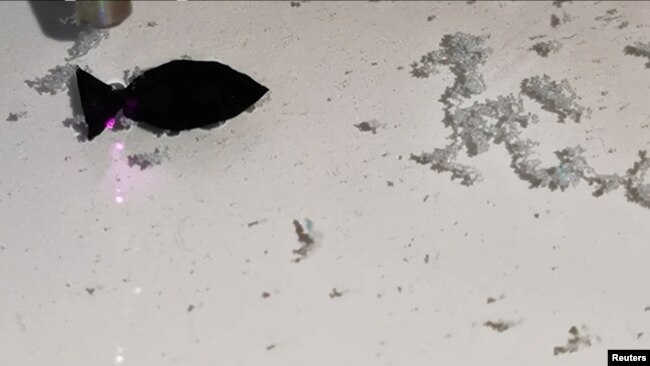驚きの研究成果が発表されました!!
さっそく、VOAで学びましょう!!
マイクロプラスチックを’食べる’ロボット魚を開発(和訳)
Scientists Develop Robotic Fish to ‘Eat’ Microplastics
July 18,2022
中国の科学者たちは、水環境からマイクロプラスチック粒子を除去することができるロボット魚を開発したと発表しました。
このプロジェクトに携わる研究者たちは、このロボットが世界中の海のプラスチック汚染の浄化に役立つと述べています。
このロボットは体長約1.3センチメートルです。柔らかい化学物質でできています。このロボットは、水中を移動しながらマイクロプラスチックを吸着するように設計されています。
このプロジェクトは、中国南西部にあるスィチュアン大学(四川大学)のチームによって立ち上げられました。研究者らは、ロボットはすでに浅い水域で良好な性能を発揮しており、より深い水域でさらにテストを行う予定と言います。
研究者らは、この研究成果をNano Letters誌に発表しています。このNano Letters誌は、米国議会が支援する非営利団体アメリカ化学会によるものです。
ロボット魚は、5ミリ以下のマイクロプラスチック粒子を対象として作られました。マイクロプラスチック汚染は、多くの自然環境で発見されていることが研究で確認されています。この物質は、製造されたプラスチック製品の分解や産業廃棄物から発生します。
このチームによると、このロボットは光で制御することができると言います。”近赤外光レーザー”をオン・オフすると、魚の尾が前後に動くと、米国化学会は述べています。
このロボット魚は、1秒間に最大2.76体長まで泳ぐことができます。これは、最も類似のソフトロボットよりも高速であると研究者らは述べています。
ワン・ユーヤン氏はシシュワン大学(四川大学)の研究チームのメンバーです。彼女はロイター通信に、この小型軽量ロボットは現在、研究目的のためにマイクロプラスチックを集めるのに使われていると言います。しかしワン氏は、研究チームはその用途を拡大し、ロボット魚が深海域からより大量のマイクロプラスチック廃棄物を除去できるようにする計画だと付け加えています。
この魚は、さまざまな種類のマイクロプラスチックを取り込むことができ、損傷した場合には自己修復することもできると研究者らは言います。また、ロボット魚が誤って本物の魚に食べられてしまっても、安全に物質を消化することができる、と研究チームは付け加えています。
ワン氏は、同様のロボットを開発すれば、人体内に設置して不要な物質や病気を取り除くことができるようになるかもしれないと述べています。
Scientists Develop Robotic Fish to ‘Eat’ Microplastics
Chinese scientists say they have developed a robotic fish that can remove microplastic particles from water environments.
Researchers working on the project say the robots could help to clean up plastic pollution in oceans around the world.
The robotic swimmers are about 1.3 centimeters long. They are made of a soft chemical compound. The robots are designed to absorb microplastics while moving through the water.
The project was launched by a team at Sichuan University in southwestern China. The researchers said the robots have already performed well in shallow water and they plan to carry out more tests in deeper waters.
The scientists reported their findings in a new study in Nano Letters. The publication comes from the American Chemical Society, a nonprofit organization supported by the U.S. Congress.
The robotic fish were built to target microplastic particles, which are smaller than five millimeters. Studies have confirmed that microplastic pollution has been discovered in many natural environments. The material comes from the breakdown of manufactured plastic products and industrial waste.
The team said the robots can be controlled by light. Turning “a near-infrared light laser” on and off causes the fish’s tail to move back and forth, the American Chemical Society said.
The robotic fish can swim up to 2.76 body lengths per second. The researchers said this is faster than most similar soft robots.
Wang Yuyan was a member of Sichuan University’s research team. She told Reuters news agency that the small, lightweight robot is currently being used to collect microplastics for research purposes. But Wang added that the team plans to expand that use so the robot fish can remove larger amounts of microplastic waste from deep ocean areas.
The fish can take in different kinds of microplastics and even repair itself when damaged, the researchers said. And if a robot fish is accidentally eaten by a real fish, it could safely digest the material, the team added.
Wang said similar robots could be developed to be placed inside the human body to remove unwanted materials or disease.
Words in This Story
absorb – v. to take liquid in through a surface
shallow – adj. not deep
digest – v. to change food in the stomach into substances the body can use
